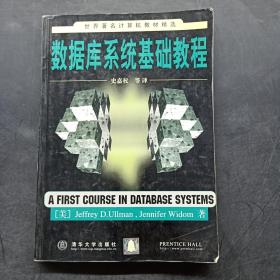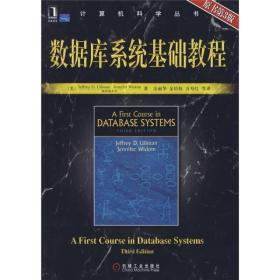
数据库系统基础教程(英文版.第3版) 英文原版书 作者
none
¥ 25.95 5.8折 ¥ 45 全新
库存3件
北京丰台
认证卖家担保交易快速发货售后保障
作者作者
出版社机械工业出版社
ISBN9787111247333
出版时间2008-08
装帧平装
开本32
定价45元
货号xhwx_10933339
上书时间2024-12-19
- 在售商品 暂无
- 平均发货时间 26小时
- 好评率 暂无
- 最新上架
商品详情
- 品相描述:全新
- 正版特价新书
- 商品描述
-
目录:
1 the worlds of database systems
1.1 the evolution of database systems
1.1.1 early database management systems
1.1.2 relational database systems
1.1.3 smaller and smaller systems
1.1.4 bigger and bigger systems
1.1.5 information integration
1.2 overview of a database management system
1.2.1 data-definition language mands
1.2.2 overview of query processing
1.2.3 storage and buffer management
1.2.4 transaction processing
1.2.5 the query processor
1.3 outline of database-system studies
1.4 references for chapter 1
ⅰ relational database modeling
2 the relational model of data
2.1 an overview of data models
2.1.1 what is a data model?
2.1.2 important data models
2.1.3 the relational model in brief
2.1.4 the semistructured model in brief
2.1.5 other data models
2.1.6 parison of modeling approaches
2.2 basics of the relational model
2.2.1 attributes
2.2.2 schemas
2.2.3 tuples
2.2.4 domains
2.2.5 equivalent representations of a relation
2.2.6 relation instances
2.2.7 keys of relations
2.2.8 an example database schema
2.2.9 exercises for section 2.2
2.3 defining a relation schema in sql
2.3.1 relations in sql
2.3.2 data types
2.3.3 simple table declarations
2.3.4 modifying relation schemas
2.3.5 default values
2.3.6 declaring keys
2.3.7 exercises for section 2.3
2.4 an algebraic query language
2.4.1 why do we need a spe query language?
2.4.2 what is an algebra?
2.4.3 overview of relational algeebra
2.4.4 set operations on relations
2.4.5 projection
2.4.6 selection
2.4.7 cartesian product
2.4.8 natural joins
2.4.9 theta-joins
2.4.10 bining operations to form queries
2.4.11 naming and renaming
2.4.12 relationshi among operations
2.4.13 a linear notation for algebraic expressions
2.4.14 exercises for section 2.4
2.5 constraints on relations
2.5.1 relational algebra as a constraint language
2.5.2 referential integrity constraints
2.5.3 key constraints
2.5.4 additional constraint examples
2.5.5 exercises for secti 2.5
2.6 summary of chapter 2
2.7 references for chapter 2
3 design theory for relational databases
3.1 functional dependencies
3.1.1 definition of functional dependency
3.1.2 keys of relations
3.1.3 superkeys
3.1.4 exercises for section 3.1
3.2 rules about functional dependencies
3.2.1 reasoning about functional dependencies
3.2.2 the splitting/bining rule
……
4 high-level database models
5 algebraic and logical query languages
6 the database language sql
7 constraints and triggers
8 views and indexes
9 sql in a server environment
10 advanced topics in relational databases
11 the semistructured-data model
12 programming languages for xml
index
内容简介:
本书由美国斯坦福大学知名计算机科学家jeffreyullman和jenniferwidom合作编写。书中介绍了核心dbm概念、理论和模型,描述了如何使用抽象语言和ql查询与更新dbm。在介绍了ql扩展内容(包括嵌入式ql程序设计和对象关系特征)后,又介绍了使用xml的系统。设计语言包括xml模式,查询语言包括xpath和xquery。
相关推荐
— 没有更多了 —























以下为对购买帮助不大的评价